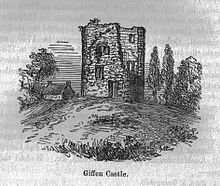Castle of Giffen
Castle of Giffen are the remains of a castle from the 15th century in the town of Beith in the Scotland administrative unit North Ayrshire .
history
The 12 meter high tower castle was located near the Mains of Giffen farm on a 50 meter high chain of hills. MacGibbon and Ross think that the Castle of Giffen was built in the 15th century, even if Walter de Mulcaster received the land in 1233, a chapel already existed there before and this suggests that there was some kind of defensive structure there even then. At the time of Pont's report (J. Dobie, 1876), it was a tower with a 9.1 mx 9.1 m base and 12 m height with 1.8 m thick walls. The castle fell into disrepair soon after 1726 and finally collapsed completely in 1838. In some old maps, the location is also called Griffen .
At the beginning of the 18th century Sir John Anstruther bought the castle and let it fall into disrepair along with the adjoining farmhouse. The sundial , which was originally in the castle garden, was sold and later moved to the Crummock House in Beith (also demolished today) . The horizontal sheet of the sundial was divided by snails, between which a lion's head and a rose alternated; it was made in 1719 and repaired in 1810. Local farmhouses were built from the building blocks of the castle ruins; the remains of the ruin were then consistently removed. Above the entrance with its strong iron door was a relief of a man shooting a wild boar with a bow and arrow. It is not unlikely that it was reminiscent of a wild hunt by a member of the von Giffen family. A similar relief on the parish church of '' Linton '' commemorates such an event, for which William the Lion knighted the rifleman and gave him the lands and the barony of Linton.
In 1837 the south wall of the castle collapsed and on April 12, 1838, in the still of the night, the north and east walls of the old castle collapsed, leaving only a messy pile of stones. The adjacent Mains of Giffen farm was leased to Robert Craig by the Anstruthers in 1726 . John King of Giffin Miln built his house out of stones from the castle and that's probably how the old reliefs came into the walls of this building. The door reveals should also come from the old castle. Thomas Craig , the grandson of Robert Craig, passed the lease on to Thomas White in 1816 ; under his aegis, the castle finally collapsed, which inspired James William , a local poet, to write the following poem:
"Hard-hearted misers worship dust,
Their covetous mind is little worth,
Secured in chains for mammon's curse,
The older they grow worse and worse!"
(German: stubborn misers worship the dust,
their eager spirit is worth little,
Secured in chains for the sake of mammons,
the older they get, the worse they get!)
In August 1956, the Ordnance Survey reported that “the remains of the Castle of Giffen now consisted of three fragments of collapsed masonry, most of them four meters long, two meters thick and 1.9 meters high. The rest of the castle was torn down around 1920 when the adjacent quarry was opened. "
In June 1983 the Ordnance Survey revisited the site and found that “there are no more remains of the castle at this point. The three fragments of masonry were actually large, fallen blocks and, together with a mass of loose, hewn stones that also came from the castle, formed a rock garden . A lintel above the entrance of the adjoining Mains House bears the inscription RC MC 1758 . This seems to come from the same time as the one-story house and its connection to the old castle is doubtful. "
Mr Robert King , the farmer at the Castle of Giffen, reported in the 1890s that while digging trenches northeast of the castle, he found a large number of bones that are rumored to be the result of one Battle that the lord of the castle and his serfs had fought against attackers. The bones are said to be located in a cave west of the castle and between this cave and the elevated area on which the castle and settlement of Giffen are located. A number of musket projectiles were found in the area using metal detectors.
Individual evidence
- ↑ a b James Dobie: Pont's Cunninghame topographized 1604-1608 with continuations and illustrative notices . John Tweed, 1876. p. 164.
- ^ T. MacGibbon, D. Ross: The castellated and domestic architecture of Scotland from the twelfth to the eighteenth centuries . 5v. Edinburgh 1887-1892.
- ↑ AH Millar: The Castles and Mansions of Ayrshire . The Grimsay Press, (1885) 2000. ISBN 1-84530-019-X . Pp. 84-85.
- ^ Sheila Jamieson: Our Village . Greenhills Women's Rural Institute, 1997. p. 13
- ^ Sheila Jamieson: Our Village . Greenhills Women's Rural Institute, 1997. p. 12
- ↑ James Paterson: History of the Counties of Ayr and Wigton . Cape. V. - III - Cunninghame. J. Stillie, Edinburgh 1863-1866. P. 98.
- ^ John Smith: Prehistoric Man in Ayrshire . Elliot Stock, 1895, p. 83.
Web links
Coordinates: 55 ° 43 '22.4 " N , 4 ° 35' 5.6" W.


